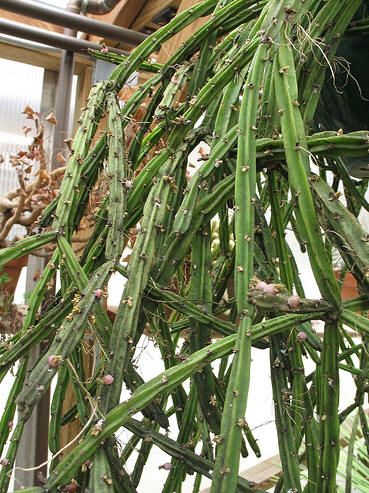Rhipsalis pentaptera A Dietrich in Allg. Gartenz. 4: 105. (1836) |
||||
R. pentaptera is an easy-to-identify species. It has 5 or 6 deep ribs and grows less pendulously than other species. New stems that grow from the center of the plant tend to arch outward rather than hang pendulously. Successive stem segments arch outward also. White flowers and pink to white fruit. From Brazil an Paraguay. Desc from B&R 1923 Plant
- branches stiff, bright green, 6 to 15 mm. in dameter, strongly 5 or
6-ribbed, the ribs indented at areoles; Notes from Bradleya 13 This
unmistakable species, well-known in cultivation, was long thought to
emanate from Southern Brazil or Uruguay, but has never been found there.
Herbarium studies have revealed only the above cited neotype collection
from 1916, whose locality is now part of the great metropolis of Rio
de Janeiro. Living material of resumably wild origin has recently been
collected from trees in gardens of the present day suburb of Sao
Conrado (immediately above the Praia da Gavea) by staff of the Cactario,
Jardim Botanico, Rio de Janeiro, where it is being maintained as part
of an admirable ex situ conservation effort. This plant is not
identical with any of the various forms of R. pentaptera seen
in cultivation elsewhere and represents a less prominently winged variant
showing a more obvious affinity with the related R.
sulcata. In its sometimes strongly winged stem-segments and multi-flowered areoles, R. pentaptera at first sight seems to provide a link between Subg. Epallagogonium and the Brazilian members of Subg. Phyllarthrorhipsalis, but its seedlings have multiple-ribbed stems of indeterminate growth and are indistinguishable from those of R. paradoxa, which fact argues strongly for its placement in the former subgenus. Desc from Hunt 2006.
Above: copyright Ken Friedman |
||||

